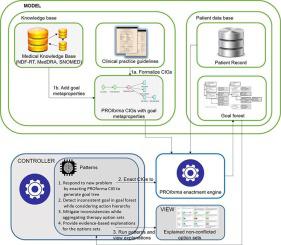Journal of Biomedical informatics ( IF 4.0 ) Pub Date : 2020-10-06 , DOI: 10.1016/j.jbi.2020.103587 Alexandra Kogan 1 , Mor Peleg 1 , Samson W Tu 2 , Raviv Allon 3 , Natanel Khaitov 3 , Irit Hochberg 4

|
Patients with chronic multimorbidity are becoming more common as life expectancy increases, making it necessary for physicians to develop complex management plans. We are looking at the patient management process as a goal-attainment problem. Hence, our aim is to develop a goal-oriented methodology for providing decision support for managing patients with multimorbidity continuously, as the patient’s health state is progressing and new goals arise (e.g., treat ulcer, prevent osteoporosis). Our methodology allows us to detect and mitigate inconsistencies among guideline recommendations stemming from multiple clinical guidelines, while consulting medical ontologies and terminologies and relying on patient information standards. This methodology and its implementation as a decision-support system, called GoCom, starts with computer-interpretable clinical guidelines (CIGs) for single problems that are formalized using the PROforma CIG language. We previously published the architecture of the system as well as a CIG elicitation guide for enriching PROforma tasks with properties referring to vocabulary codes of goals and physiological effects of management plans.
In this paper, we provide a formalization of the conceptual model of GoCom that generates, for each morbidity of the patient, a patient-specific goal tree that results from the PROforma engine’s enactment of the CIG with the patient’s data. We also present the “Controller” algorithm that drives the GoCom system. Given a new problem that a patient develops, the Controller detects inconsistencies among goals pertaining to different comorbid problems and consults the CIGs to generate alternative non-conflicted and goal-oriented management plans that address the multiple goals simultaneously. In this stage of our research, the inconsistencies that can be detected are of two types – starting vs. stopping medications that belong to the same medication class hierarchy, and detecting opposing physiological effect goals that are specified in concurrent CIGs (e.g., decreased blood pressure vs. increased blood pressure). However, the design of GoCom is modular and generic and allows the future introduction of additional interaction detection and mitigation strategies. Moreover, GoCom generates explanations of the alternative non-conflicted management plans, based on recommendations stemming from the clinical guidelines and reasoning patterns.
GoCom’s functionality was evaluated using three cases of multimorbidity interactions that were checked by our three clinicians. Usefulness was evaluated with two studies.
The first evaluation was a pilot study with ten 6th year medical students and the second evaluation was done with 27 6th medical students and interns. The participants solved complex realistic cases of multimorbidity patients: with and without decision-support, two cases in the first evaluation and 6 cases in the second evaluation.
Use of GoCom increased completeness of the patient management plans produced by the medical students from 0.44 to 0.71 (P-value of 0.0005) in the first evaluation, and from 0.31 to 0.78 (P-value < 0.0001) in the second evaluation. Correctness in the first evaluation was very high with (0.98) or without the system (0.91), with non-significant difference (P-value ≥ 0.17). In the second evaluation, use of GoCom increased correctness from 0.68 to 0.83 (P-value of 0.001). In addition, GoCom’s explanation and visualization were perceived as useful by the vast majority of participants.
While GoCom’s detection of goal interactions is currently limited to detection of starting vs. stopping the same medication or medication subclasses and detecting conflicting physiological effects of concurrent medications, the evaluation demonstrated potential of the system for improving clinical decision-making for multimorbidity patients.
中文翻译:

面向目标的方法,为多发病患者提供基于临床指南的管理建议:GoCom及其初步评估
随着预期寿命的增加,患有慢性多发病的患者变得越来越普遍,这使得医生有必要制定复杂的管理计划。我们正在将患者管理过程视为实现目标的问题。因此,我们的目标是开发一种面向目标的方法,以随着患者的健康状况的发展和新目标的出现(例如,治疗溃疡,预防骨质疏松症)不断为管理多发病的患者提供决策支持。我们的方法使我们能够发现和缓解源自多个临床指南的指南建议之间的不一致,同时咨询医学本体和术语并依靠患者信息标准。这种方法及其作为称为GoCom的决策支持系统的实现,从使用PROforma CIG语言形式化的单个问题的计算机可解释临床指南(CIG)开始。我们之前曾发布过系统的体系结构以及CIG启发性指南,以利用与目标词汇表代码和管理计划的生理效应有关的属性来丰富PROforma任务。
在本文中,我们提供了GoCom概念模型的形式化信息,该模型为患者的每种发病率生成了特定于患者的目标树,该树是由PROforma引擎根据患者数据制定CIG产生的。我们还提出了驱动GoCom系统的“控制器”算法。给定患者发展出的新问题,财务主任会发现与不同合并症相关的目标之间存在不一致,并咨询CIG以生成可同时解决多个目标的替代性非冲突且面向目标的管理计划。在我们研究的这一阶段,可以检测到的不一致有两种类型-属于相同药物类别层次结构的开始或停止药物;并检测并发CIG中指定的相反的生理效应目标(例如,降低血压与提高血压)。但是,GoCom的设计是模块化且通用的,并允许将来引入其他交互检测和缓解策略。此外,GoCom会根据临床指南和推理模式提出的建议,生成其他非冲突管理计划的解释。
GoCom的功能通过我们的三位临床医生检查过的三例多发病相互作用进行了评估。通过两项研究评估了实用性。
第一次评估是对10名6年级医学生的试点研究,而第二次评估是对27名6年级医学生和实习生进行的。参与者解决了多发病例的复杂现实案例:有或没有决策支持,第一次评估为2例,第二次评估为6例。
GoCom的使用使医科学生制定的患者管理计划的完整性在第一次评估中从0.44增至0.71(P值0.0005),在第二次评估中从0.31增至0.78(P值<0.0001)。使用(0.98)或不使用系统(0.91),第一次评估的正确性都很高,差异无统计学意义(P值≥0.17)。在第二次评估中,使用GoCom将正确性从0.68提高到0.83(P值为0.001)。此外,绝大多数参与者都认为GoCom的解释和可视化很有用。
虽然GoCom目前对目标相互作用的检测仅限于检测开始或停止相同药物或药物亚类,以及检测并发药物的相互矛盾的生理效应,但评估表明该系统具有改善多发病患者临床决策的潜力。











































 京公网安备 11010802027423号
京公网安备 11010802027423号